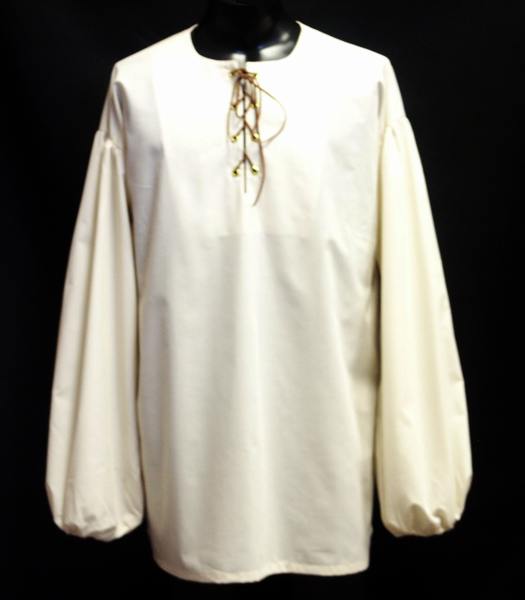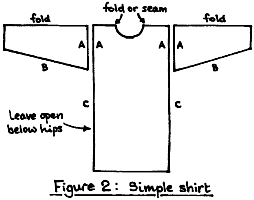Shirts
Shirts tended to be fairly close-fitting about the neck and wrists. To allow the head to go through the neck hole, there was a small slit at the front, which could be held closed by a brooch if desired. Shirt sleeves came down to the wrist and were often long enough to bunch up on the forearm.
The basic costume for men up to at least 1300AD was shirt, tunic and hose. The shirt and tunic would be based on the simple "T-tunic" pattern. The shirt would most likely be of linen and the tunic of wool. The length of both shirt and tunic varied with period. Knee-length was common. To allow free movement of the legs, the garment would either widen out below the waist to give a full "skirt", or would be slit to about hip level. Slits were usually at the sides, but were sometimes at front and back.
History of Undershirts and Tunics
Although often completely hidden by outer garments, its necessity in this age before hot baths, cheap soap, and washing machines is obvious to anyone who has worn a wool suit jacket. There are occasional glimpses of coloured and even embroidered undersleeves poking out from cuffs; however, bearing in mind that this would probably be the most-washed garment on the body, I find it highly unlikely that these are glimpses of the undermost shirt. It is possible that these are sometimes faux-sleeves.
Fashion is conservative, usually differing more in minor hem length and tailoring than in actual innovation, even between generations. The garment in question here was not even meant to be seen by anyone beyond the immediate household. When the outer tunics are being cut with rectangular sleeves + square gores, it is a sure bet that the underwear is no fancier. But what about during the cotehardie craze (c 1350-1450), when 'Cut Was King'? Wouldn't a square-cut sleeve produce unsightly bunching, when milady was tightly laced into her sensuously-curved cotehardie top? The cost of a tailored sleeve is two-fold: tailoring time and wasted material. A T-tunic can be cut without any waste at all. The burial shirt of Saint Louis shows that scraps cut from the neckhole were cleverly fashioned into neckline facing and gores for the armscye (the armpit region of the sleeve).
Personal experience in the SCA shows that underneath most lined cotehardies, armscye bunching does not show through. Under heavy fabric (velvet, heavy jacquards, fustian, etc), this would certainly be true. Relatively square sleeves and body patterns were de rigueur in the previous century, and were haute couture in the poofy-shirt era of the next century.
The shirt never needs to be so well tailored in the chest that it would require lacing or buttoning, nor have I ever seen a depiction of such a medieval shirt. A simple linen shirt, spreading out comfortably from the mid-point of the armscye, can be worn with a simple lace or button at the throat to close the collar. In order to protect high outer collars from sweat, a courtier would need a shirt that had a collar as well (although it might be a simple standing collar). If any mere shirts did have a button closure, the buttons were most likely handmade fabric ball-buttons. This is an age where a gift of some pins was the romantic equivalent of a bouquet of flowers; metal was not cheap, and neither were horn buttons.
The shirt appears to show at the cuff and hems of 11th through 13th c garments, even for the well-to-do. Sometime after this, it appears to be banished from the view of polite society until the Renaissance. There is still some argument for men's shirts retaining enough length to cover the crotch, even after outer hemlines rose. A crotch-length tunic is far warmer in the privy and while dressing, and it is at these moments (experience shows) that every bit counts. It's a simple matter to hike a longer shirt up underneath a fitted cotehardie, out of sight. In fact, as the painting of the execution to the right reveals (from an edition of Froissart's Chronicles, c1425), both generous sleeves and long hems could be hidden beneath tightly tailored clothing.
Padded, Doubled, & Fitted Undertunics: Gypons/Jupons/Paltocks/Gambesons/Doublets
In the late 14th c the hemlines rose so high that it was necessary to tie them to an outer garment. This temporarily relieved tailors of the problem presented by fitting garments over the seat; hosen tied to a shirt had more room to move and stretch (from the shoulders) than if they were still tied to the waist. It also provided surer modesty and warmth, since it ensured there would be no gapping at the waistline. By the 15th c, this garment had migrated from under- to outer wear.
A simple shirt would not hold up to the daily tugging of points from a pair of hosen. The undertunic, which had become fitted along the lines of the cotehardie, was rugged enough for the task, and was outfitted with 4-6 or more pairs of holes through which the points of the hosen were passed & tied. As mentioned earlier, a medieval technique for making strong holes in fabric was to spread the threads out from a single "gap" in the weave with radial button stitches; thus, the fabric is never cut. It is reasonable to assume this buttonhole technique was also used here, to pass braided cords through.
Supposedly, this garment became heavily padded in the chest during the last decade of the 14th c, producing the "pigeon-breasted" apearance of young dandies seen in illustrations of King Richard II's court. I have been unable to conclusively verify this super-padding. In civilian garments; it may merely be an artistic convention, like the demi-grapefruit breasts which mysteriously grew from the chests of virgins in this period. On the other hand, this huge chest effect of young dandies continues into the Lancastrian regime, with seam details that were missing in most of these Richard II-era depictions.
The corresponding military garment, the gambeson, was certainly padded. The very word "gambeson" comes from the Anglo-Norman French word gambeisé, "quilted".
How to
A basic T-tunic style shirt. The method of construction is to take a strip of material long enough to go over the head and hang down to the desired length front and back. Alternatively, join two pieces to form such a strip. The strip should be wide enough so that the finished garment can be pulled on over your head and shoulders - it's meant to be loose-fitting around the body. Cut out a circular hole for the neck. This hole should be offset toward the front of the garment, as you can see by looking at a modern shirt or jumper. Cut a slit down the front, just long enough to allow the shirt to go over your head. It's difficult to turn over the edges of a circular hole to make a hem, so I trim the edges of the neck opening with bias binding. (Use 1"/25mm binding folded in half.) Next, lay the fabric out, unfolded, and attach the sleeves to the body (A-A). Fold again, then sew along the sleeves and down to hip level (B & C). Finally, neatly hem the cuffs and the bottom of the tunic, or trim with bias binding. A wider binding (2"/50mm) looks nice round the bottom.
Links
- For sale at MC
- For sale at BTS
- for sale at MU
- For sale at 'your dressmaker'
- For sale at MR
- Great how to with pictures

